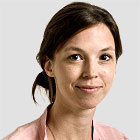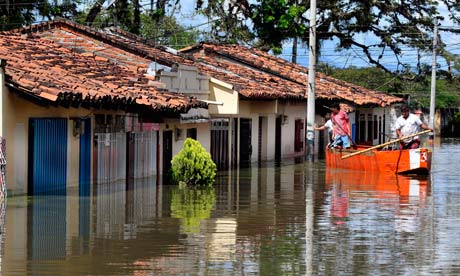
Annie Kelly 21 February 2011 : guardian.co.uk
Low-cost insurance that covers the lives, health and property of the poor could provide protection against natural disasters

People travel by boat through a flooded street of a town in Colombia. Photograph: Carlos Ortega/EPA
In December 2010 devastating flooding in Colombia killed more than 200 people and left 1.7 million homeless. The damage caused was catastrophic, with 628 cities and towns hit by floodwaters, over 1,800 homes destroyed and a further 256,000 damaged.
Like the victims of most natural disasters across the world, the vast majority of those who lost relatives, homes and belongings, many of them poor farmers living in isolated rural areas, will receive no compensation for their losses and will have to rebuild their lives from scratch.
With the floods largely ignored by the international community, government assistance patchy and slow, and aid agencies struggling to fill the void, Colombia's insurance agencies are saying they can provide a much-needed safety net for when the rains return.
Microinsurance, low-cost insurance policies that cover the lives, health, crops and property of the most vulnerable, are being seen as a central way of providing social protection to the increasing numbers of people affected by natural disasters such as hurricanes, flooding and drought.
A recent report by the German insurance giant Munich Re calculated that 2010 was the second worst year for disasters since 1980. It reported that 950 global catastrophes had amounted to overall losses of around $130bn. Of this, only around $37bn was insured. For example, only 1% of the $14bn of property damage caused by Haiti's massive earthquake was covered by insurance.
At the Bonn climate change talks in 2008, microinsurance was touted as a central component of climate change adaptation measures in Africa, Asia and Latin America.
Yet while microinsurance has seen increasing success in Africa and Asia, it has so far failed to make significant inroads into the Latin American market. But this could be changing.
The Colombian offices of insurance companies such as Liberty and ESA have told journalists that they are seeing a spike in the number of people taking out microinsurance policies. ESA says it is selling more than 60,000 microinsurance policies a month, mostly health , for around $1 a month.
There are hopes that microinsurance could offer some form of social protection in other countries across the region. A government-backed scheme run by Peruvian insurance company La Positiva targets over one-third of Peru's 9 million rural population, offering micro-life insurance at a marginal cost of the income generated by a family's annual harvest.
The cost of the insurance, which is between $0.5 and $2 a month, is added to the water irrigation price already paid by the farmers. Brazil and Mexico have also been identified as huge markets for growth, with millions of potential customers.
Yet despite the buzz surrounding microinsurance, the industry's reach is still limited. The 150 million people currently holding policies represent only a small fraction (around 5%) of a potential market of up to 3 billion.
Unlike microfinance programmes that provide people with instant cash, the insurance industry has so far struggled to overcome the simple problem of trying to ask poor people to pay for something they might never use.
Richard Leftley, the chief executive of UK-based MicroEnsure, one of the leading microinsurance companies, says that it has all but scraped the idea of trying to sell policies direct. He says turning up in towns and villages and asking poor families to buy insurance simply doesn't work. "Trying to explain to someone with no prior experience of insurance that if you pay even just a little bit every month then someone will pay you back if your crops failed or your child is hospitalised is often met with a perfectly understandable 'yeah right' response," he says.
Instead, the industry is evolving, with many policies now being sold as add-ons to products and brands that people already use and trust. For example, MicroEnsure says it is now conducting most of its business in Africa through partnerships with mobile phone companies.
Phone companies trying to get people to stop using multiple sim cards and stay loyal to one air-time provider are offering life or health and disaster insurance as an incentive. People who buy credit for one month get a month's worth of insurance at no extra cost.
Other obstacles are also stunting the potential of microinsurance as a widely used financial service for those vulnerable to natural disasters.
Weather-based claims have proved tricky. Microinsurance companies have had to dictate levels of rainfall as a way of setting limits for claims. Leftley says problems have occurred when these limits haven't quite been reached yet farmers still believed their crops had been damaged and expected compensation.
Major insurance firms are still being put off entering the market because microinsurance claims have to have few, if any, exclusions. Claims have to be paid almost instantly. It only takes one company to fail to pay out to its customers for years of fragile trust-building to be destroyed in an instant.
Yet Leftley believes microinsurance's time has come. He points to the increasing backlash against microfinance as a "fix-all" solution to poverty as stories mount of families being put under unbearable and devastating pressure to pay back microfinance debts.
"I think credit has been seen as the easy solution for global poverty, and the micro-finance industry has been drinking its own Kool-Aid for a bit too long," he says. "While credit is the best option in some situations, people are starting to realise that there are other options – and this can only be good for the microinsurance industry."
http://www.guardian.co.uk/global-development/poverty-matters/2011/feb/21/micro-insurance-protect-poor











No comments:
Post a Comment